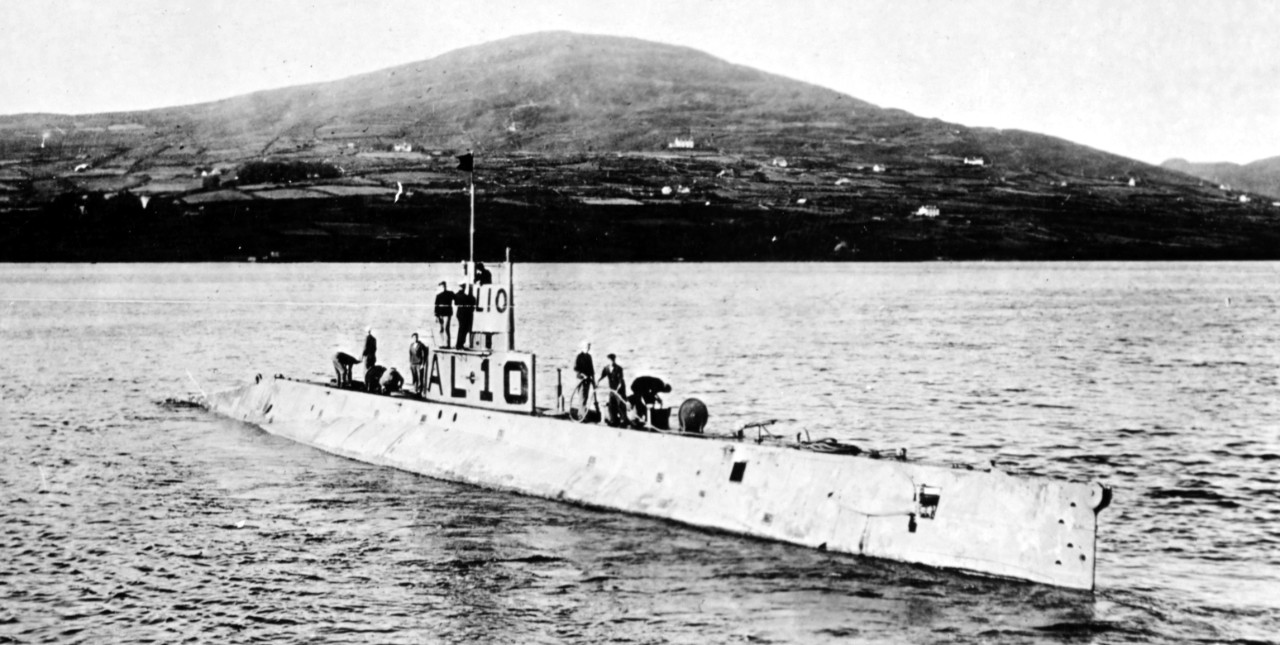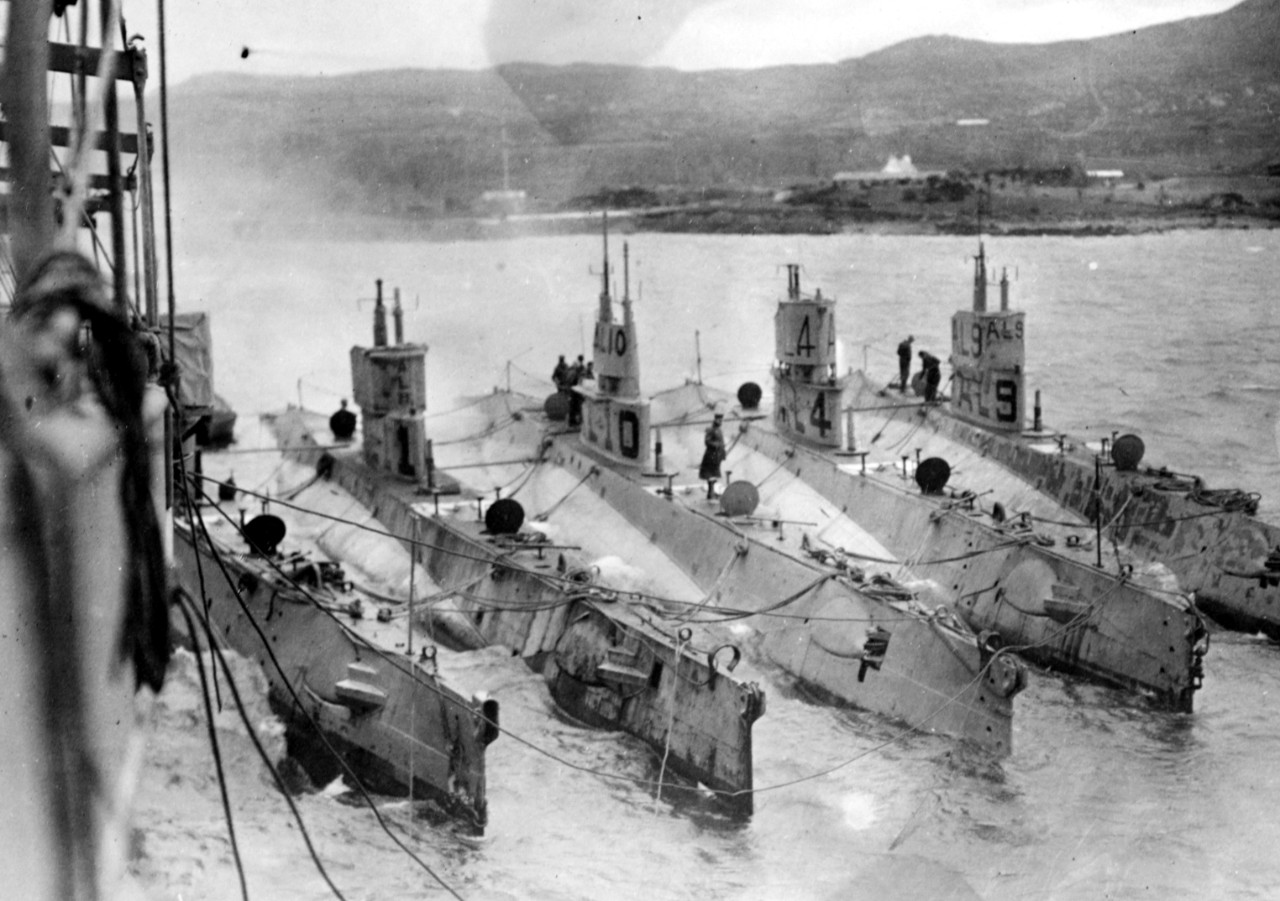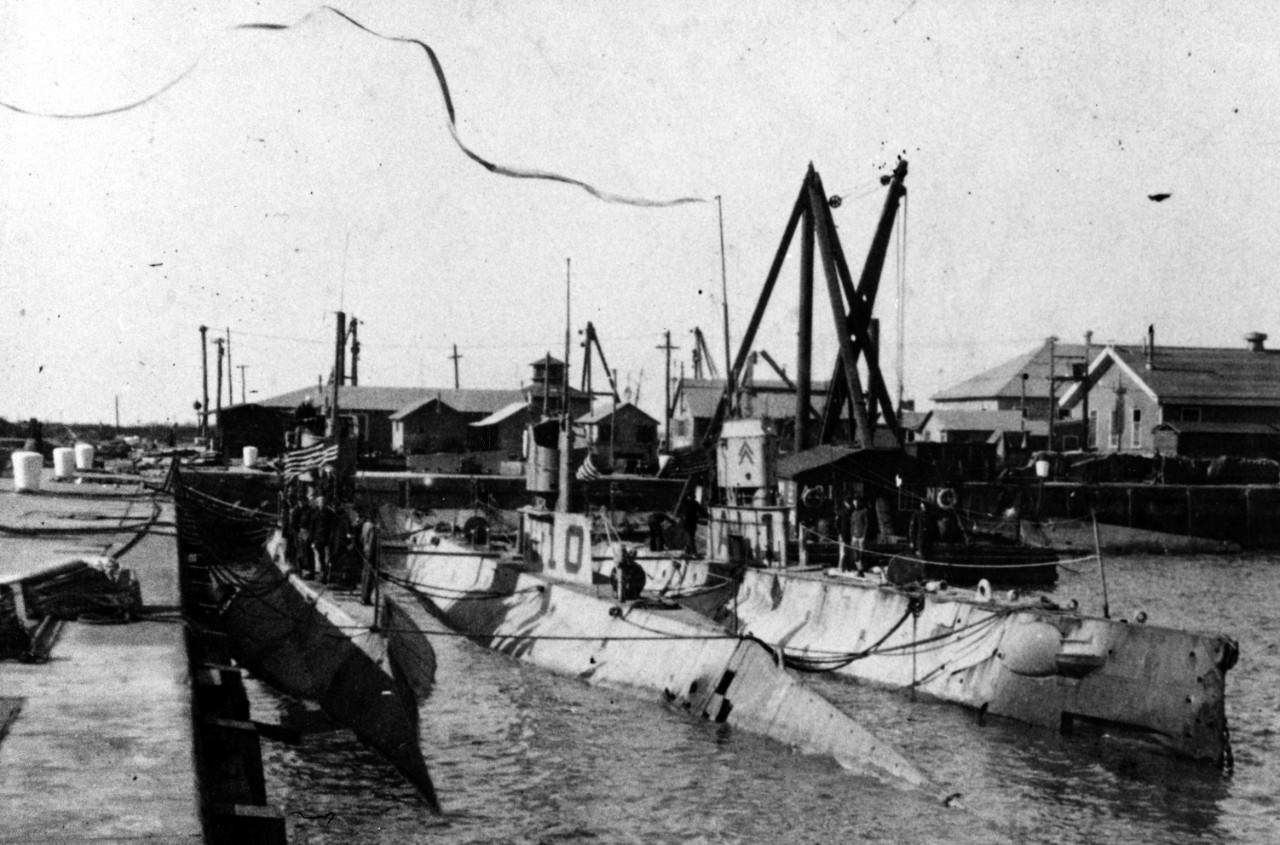L-10 (Submarine No. 50)
1916–1922
(Submarine No. 50: displacement 450 (surface), 548 (submerged); length 167'5"; beam 17'5"; draft 13'7"; speed 14 knots (surface), 10.5 knots (submerged); complement 28; armament 1 3-inch, 4 18-inch torpedo tubes; class L-1)
L-10 (Submarine No. 50) was laid down on 17 February 1915 at Quincy, Mass., by Fore River Shipbuilding Co. as a sub-contractor for Electric Boat Co.; launched on 16 March 1916; sponsored by Miss Catherine Rush, daughter of Capt. William R. Rush, commander of the Boston (Mass.) Navy Yard; and commissioned at the Boston Navy Yard on 2 August 1916, Lt. (j.g.) James C. Van de Carr in command.
L-10, with the division’s organization on 5 August 1916, was assigned to Division Six, Submarine Force, Atlantic Fleet. The submarine got underway on 12 August, clearing Boston for Provincetown, Mass., and returning that same day. She cleared Boston a week later, on 19 August, and conducted maneuvers and training until her return on the 27th. Standing out from Boston on 9 September, the submarine proceeded southward with port visits at Newport, R.I. (9–10 September); Tompkinsville [Staten Island], N.Y. (19–20 October); Hampton Roads, Va. (22–23 September); Rappahannock Spit, Va. (23–24 September); Norfolk, Va. (24–27 October) before returning to the Boston Navy Yard on 30 October. Having remained there for almost two months, L-10 cleared Boston on 23 December bound for Key West, Fla. En route, she visited Charleston, S.C. (28–30 December), and arrived at Jacksonville, Fla. on 31 December.
Having spent New Year’s Day 1917 in port, L-10 sailed the next day, 2 January, reaching Key West on 4 January. She remained there until 22 January, when she proceeded to the Dry Tortugas (22–26 January), en route to Pensacola, Fla. She remained in the waters off Pensacola, conducting torpedo practice and maneuvers to 27 March. L-10 was ordered to return to the east coast as a result of increased tensions with Imperial Germany stemming from its resumption of unrestricted submarine warfare on 1 February. Proceeding via Key West (31 March), the boat stood in to the Norfolk Navy Yard, Portsmouth, Va., on 6 April., the same day the United States declared war on Germany. Three days later, the submarine shifted to the Submarine Base at Hampton Roads. L-10 departed Hampton Roads on 9 April and after touching at Ambrose Channel (11 April), stood in to Submarine Base, New London, Conn., on the 12th. Here at Base No. 22, her crew received instruction and underwent further training. L-10 with her division- mates L-9 (Submarine No. 49) and L-11 (Submarine No. 51), received orders on 30 April directing them to proceed to the Boston Navy Yard for scheduled maintenance. They were to sail in convoy with Tonopah (Monitor No. 8), which was to serve as tender. Departing on 6 May, the submarines transited the Cape Cod Canal and reached the Boston Navy Yard on 8 May.
In June 1917, Vice Adm. William S. Sims, Commander, U.S. Naval Forces in European Waters, cited British success in using submarines to destroy other submarines. The Allied submarines, with their lower profiles, could approach U-boats more stealthily than larger surface patrol vessels. On 2 July, Adm. William S. Benson, Chief of Naval Operations, ordered the twelve most suitable submarines on the Atlantic coast be fitted out for duty in European waters.
Having undocked, L-10 was standing in to Boston Harbor off Spectacle Island, when she was rammed on 11 August by the Nantasket Company’s vessel Mayflower. The collision saw the submarine damaged and she was ordered to Fore River for repairs. The incident prompted a hearing by the Steamboat Inspection Service and a further investigation by the Navy. While the former found Mayflower at fault, the latter faulted both vessels because both were proceeding at too great a speed given the conditions. Furthermore, Mayflower did not stop upon hearing L-10’s whistle, while the submarine was on the wrong side of the channel for entering port, circumstances that made an incident unavoidable. After her repairs, L-10 left dry dock on 16 October.
The Sixth Division received orders on 28 October 1917 to proceed via the Cape Cod Canal to Newport to conduct training in preparation for distant service. In the first weeks of November, the submarine conducted exercises submerged and carried out torpedo firing in the waters around Newport and the Torpedo Station at Melville, R.I. In company with L-1 (Submarine No. 49), L-2 (Submarine No. 49); L-3 (Submarine No. 49); L-4 (Submarine No. 49); L-9; L-11; E-1 (Submarine No. 24); Bushnell (Submarine Tender No. 2) [with Capt. Thomas C. Hart, Commander, Submarine Flotilla embarked]; and Fulton (Submarine Tender No. 1), L-10 cleared Narragansett Bay on 4 December.
Having charted a direct course to the Azores, Hart’s force ran into a gale which scattered them and required a pause to re-assemble at Bermuda (Base No. 24) on 13 December 1917. L-10 then proceeded to Ponta Delgada, Azores (Base No. 13) where she arrived on 18 December with L-1. After undergoing repairs, L-10 conducted patrols into the New Year in the waters of the Portuguese archipelago to deny their use by German U-boats and surface raiders. Clearing the Azores on 19 January 1918, she proceeded to Ireland, during which passage, at about 12:30 p.m. on 25 January, GM1c Royal A. Leese was lost overboard. L-10 reached Berehaven Island, [Castletownbere], Bantry Bay, Ireland, the next day.
Though under the nominal command of Vice Adm. Sims, Hart’s U.S. submarines in Ireland, to be based at Queenstown [Cobh] (Base No. 6), came under the authority of Vice Adm. Sir Lewis Bayly, RN, Commander-in-Chief, Coast of Ireland, and Capt. Sir Martin E. Nasmith (later Dunbar-Nasmith), RN, his submarine commander. Bayly initially ordered Hart to deploy only one of his submarines at a time at sea, and that Royal Navy officers were to always be informed of departures and returns. Their patrol area was also to be limited to seaward of the Fastnet Light, so as to keep clear of British patrols and to avoid potentially fatal “friendly fire” incidents. The base at Queenstown, however, proved unsatisfactory for Lt. Cmdr. Harold M. Bemis’ submarines [now designated Division Five], as it was also serving as the headquarters for the surface patrol forces. As a result, the U.S. submarines were relocated to Berehaven.
L-10 operated with Downes (Destroyer No. 45) (2–5 February 1918) to train the latter’s oscillator operators. In the ensuing days (6–16 February), the division trained in Bantry Bay conducting dives and tactical maneuvers under the charge of the commander of the Royal Navy’s Submarine Flotilla on board HMS Ambrose also based at Berehaven. U.S. submarine officers also trained with a “submarine attack war game” apparatus on board the submarine depot ship HMS Vulcan. In order to differentiate them from the British L-class submarines, the U.S. boats were re-designated with the prefix “A” (American) and the letter was painted onto their fairwaters. The American submarines’ patrols were to be based on eight-day rotations, there would be eight days on patrol and eight days in port for overhaul, re-provision, and rest in preparation for the next eight-day patrol.
AL-10 departed Berehaven on 22 March 1918 at 12:30 p.m. for a patrol of sector QA, which she conducted from 23–29 March. During that time, Trippe (Destroyer No. 33) mistook AL-10 for a German U-boat on 25 March and dropped depth charges on an oil slick, but at some distance that proved to be no danger to the boat. AL-10 subsequently surfaced and deployed a recognition signal. While Trippe later reported that the calm and clear conditions enabled her to track the submarine’s movements, investigation revealed that AL-10, due to faulty navigation, was not in her proper patrol section. This, in combination with the observable oil slick, prompted her being observed and attacked with depth charges.

After additional patrols, AL-10 arrived for refit at Queenstown on 15 April 1918. The submarine cleared Queenstown on 8 May, with her yard work completed, and returned to Berehaven, after which she resumed her rotation of patrols and time in port. On 4 August, she was conducting an exercise with AL-1 in which the torpedo fired malfunctioned and was lost. On 29 August, AL-9 and AL-10 began conducting training exercises. Upon completing that evolution each deployed to their respective patrol sector off Ireland and made their return to Berehaven on 14 September. The submarine continued her scheduled routine into November, shifting to Portland, England, for training. She was still there when the Armistice ended hostilities on 11 November.

After the Armistice, AL-10 remained in British waters until sailing for the United States on 3 January 1919. Proceeding via the Azores and Bermuda, AL-10 reached the Philadelphia (Pa.) Navy Yard with the other submarines of her division on 1 February.

L-10 underwent post-deployment overhaul and refit at Philadelphia after which, on 26 May 1919, she proceeded to the Submarine Base, Hampton Roads. Operating from either that place or the Norfolk Navy Yard, Portsmouth, Va., she conducted training and developed submarine tactics in the waters of the lower Chesapeake Bay and the Virginia capes. She cleared Hampton Roads and went to sea on 16 July. Returning to Hampton Roads on 28 July, she remained there until 8 September, when she proceeded up the Chesapeake to make visits to Annapolis, Md. (9–10 September) and Baltimore, Md. (11–17 September). She returned to Hampton Roads on 18 September and remained there until moving to Norfolk on 18 November. She would remain at the Norfolk Navy Yard until 19 August 1920, when she shifted to Hampton Roads. During this time, on 17 July 1920, she was redesignated SS-50 as part of a Navy-wide administrative re-organization. The submarine cleared Hampton Roads on 26 August and proceeded up the Chesapeake and into the Potomac River to visit the Washington Navy Yard (27–29 August). She then returned to Hampton Roads (31 August–16 October). Clearing the Submarine Base, she made a visit to Hamilton, Bermuda (21–25 October), before returning to Hampton Roads.
L-10, now assigned to the Repair Division, departed Hampton Roads for the final time on 8 January 1921 and arrived the following day at the Philadelphia Navy Yard. Just over two months later, on 26 March, the Repair Division was dissolved and L-10, along with L-1, L-2, L-3, L-4, L-9, L-11, and E-1, were re-assigned to Submarine Division Three which was based on an inactive status at Philadelphia.
L-10 was decommissioned at the Philadelphia Navy Yard on 5 May 1922. Sold as a hulk on 31 July 1922 to Joseph G. Hitner Co. of Philadelphia, she was removed from the Philadelphia Navy Yard on 19 September 1922, and delivered to her purchaser for scrapping.
| Commanding Officers | Dates of Command |
| Lt. (j.g.) James C. Van de Carr | 2 August 1916–22 April 1918 |
| Lt. Schuyler Mills | 22 April 1922–17 September 1918 |
| Lt. Vincent A. Clarke Jr. | 17 September 1918–3 November 1919 |
| Lt. William K. Beard | 3 November 1919–23 February 1920 |
| Lt. (j.g.) John E. Dingwell | 23 February 1920–22 April 1920 |
| Lt. (j.g.) George C. Dyer | 22 April 1920–1 July 1920 |
| Lt. Theodore T. Patterson | 1 July 1920–15 December 1920 |
| Lt. Robert P. Luker | 15 December 1920–10 January 1921 |
| Lt. (j.g.) John L. Wilson | 10 January 1921–17 December 1921 |
| Lt. Bartley G. Furey | 17 December 1921–31 July 1922 |
Christopher B. Havern, Sr.
1 April 2019


